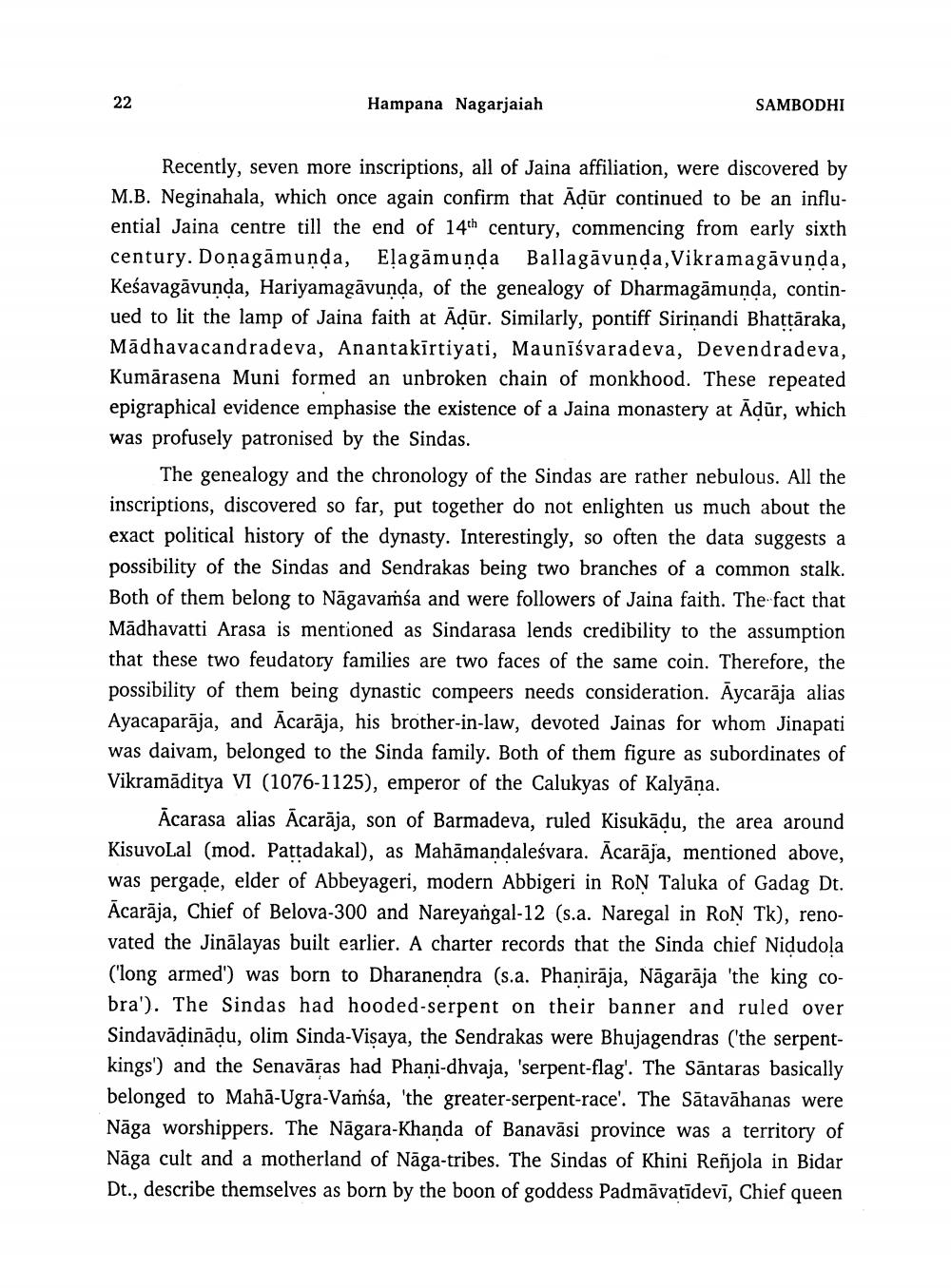________________
22
Hampana Nagarjaiah
SAMBODHI
Recently, seven more inscriptions, all of Jaina affiliation, were discovered by M.B. Neginahala, which once again confirm that Adūr continued to be an influential Jaina centre till the end of 14th century, commencing from early sixth century. Donagāmunda, Elagāmunda Ballagāvunda, Vikramagāvunda, Keśavagāvunda, Hariyamagāvunda, of the genealogy of Dharmagāmunda, continued to lit the lamp of Jaina faith at Ādūr. Similarly, pontiff Sirinandi Bhattāraka, Madhavacandradeva, Anantakīrtiyati, Maunisvaradeva, Devendradeva, Kumārasena Muni formed an unbroken chain of monkhood. These repeated epigraphical evidence emphasise the existence of a Jaina monastery at Ādūr, which was profusely patronised by the Sindas.
The genealogy and the chronology of the Sindas are rather nebulous. All the inscriptions, discovered so far, put together do not enlighten us much about the exact political history of the dynasty. Interestingly, so often the data suggests a possibility of the Sindas and Sendrakas being two branches of a common stalk. Both of them belong to Nāgavamsa and were followers of Jaina faith. The fact that Mādhavatti Arasa is mentioned as Sindarasa lends credibility to the assumption that these two feudatory families are two faces of the same coin. Therefore, the possibility of them being dynastic compeers needs consideration. Āycarāja alias Ayacaparāja, and Ācarāja, his brother-in-law, devoted Jainas for whom Jinapati was daivam, belonged to the Sinda family. Both of them figure as subordinates of Vikramāditya VI (1076-1125), emperor of the Calukyas of Kalyāna.
Acarasa alias Acarāja, son of Barmadeva, ruled Kisukādu, the area around KisuvoLal (mod. Pattadakal), as Mahāmandaleśvara. Acarāja, mentioned above, was pergade, elder of Abbeyageri, modern Abbigeri in RON Taluka of Gadag Dt. Ācarāja, Chief of Belova-300 and Nareyangal-12 (s.a. Naregal in Ron Tk), renovated the Jinālayas built earlier. A charter records that the Sinda chief Nidudola ('long armed') was born to Dharanendra (s.a. Phanirāja, Nāgarāja 'the king cobra'). The Sindas had hooded-serpent on their banner and ruled over Sindavādinādu, olim Sinda-Visaya, the Sendrakas were Bhujagendras ('the serpentkings') and the Senavāras had Phani-dhvaja, 'serpent-flag'. The Sāntaras basically belonged to Mahā-Ugra-Vamśa, 'the greater-serpent-race'. The Sātavāhanas were Nāga worshippers. The Nāgara-Khanda of Banavāsi province was a territory of Nāga cult and a motherland of Nāga-tribes. The Sindas of Khini Reñjola in Bidar Dt., describe themselves as born by the boon of goddess Padmāvatidevī, Chief queen




